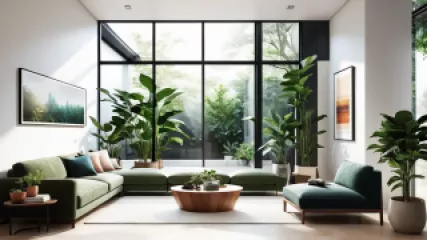The Profound Impact of Space Design on Mental Well-being
Have you ever noticed how certain spaces make you feel calm and at ease, while others leave you feeling stressed or anxious? The design of our physical environment has a profound impact on our mental well-being. From the layout of a room to the choice of colors and materials, every aspect of space design can influence our emotions, thoughts, and overall psychological state. In this opinion piece, we will explore the psychology of space design and the significant role it plays in supporting our mental health.
The Power of Environmental Psychology
Environmental psychology is a field of study that examines the relationship between humans and their physical surroundings. It explores how different environmental factors, such as lighting, noise levels, and spatial organization, can affect our behavior, mood, and cognitive functioning. By understanding the principles of environmental psychology, designers can create spaces that promote well-being and enhance our mental health.
One of the fundamental concepts in environmental psychology is the idea of biophilia. This term coined by biologist E.O. Wilson suggests that humans have an innate connection to nature and thrive when surrounded by natural elements. Incorporating elements of nature, such as plants, natural light, and views of the outdoors, into interior spaces can have a positive impact on our mental well-being.
The Impact of Colors
Colors have a powerful influence on our emotions and can significantly impact our mental state. Different colors evoke different feelings and can either energize or relax us. For example, warm colors like red and orange are often associated with excitement and stimulation, while cool colors like blue and green are linked to calmness and relaxation.
When designing spaces for mental health support, it is crucial to consider the emotional impact of color choices. For instance, soft blues and greens are often used in therapy rooms to create a sense of tranquility and promote a safe and calm environment. In contrast, vibrant and bold colors might be used in areas where creativity and inspiration are encouraged.
The Role of Lighting
Lighting is another critical aspect of space design that can greatly influence our well-being. Natural light has a multitude of benefits for mental health, including boosting mood, regulating sleep patterns, and improving productivity. Exposure to natural light has even been linked to a decrease in symptoms of depression and anxiety.
When designing spaces for mental health support, maximizing natural light should be a priority. Large windows, skylights, and the use of reflective surfaces can help bring more natural light into a space. In areas where natural light is limited, artificial lighting should be carefully selected to mimic the qualities of natural light. Warm, soft lighting can create a cozy and comforting atmosphere, while bright, cool lighting can promote focus and alertness.
The Importance of Spatial Organization
The way a space is organized can also significantly impact our mental well-being. Cluttered and disorganized environments can increase stress levels and make it challenging to focus and relax. On the other hand, well-organized spaces can promote a sense of calmness and provide a clear mind.
When designing spaces for mental health support, it is crucial to consider the flow and functionality of the space. Creating designated areas for different activities, such as relaxation, reflection, and social interaction, can help individuals navigate the space more effectively and engage in the desired activities. Additionally, incorporating storage solutions and minimizing visual clutter can contribute to a more organized and soothing environment.
The Rise of Virtual Counseling Services
In recent years, there has been a significant increase in the availability of virtual counseling services. These online platforms provide individuals with access to mental health support from the comfort of their own homes. While virtual counseling offers convenience and accessibility, it also presents unique challenges in terms of space design.
When engaging in virtual counseling sessions, individuals must consider the design and arrangement of their physical space. Creating a dedicated area for counseling sessions can help establish boundaries and promote a sense of privacy. This space should be free from distractions and designed to foster a calm and supportive atmosphere. By intentionally designing their counseling space, individuals can enhance the effectiveness of their virtual therapy sessions.
The Future of Interior Design for Mental Health
As our understanding of the relationship between space design and mental health continues to grow, there is an increasing focus on creating environments that prioritize well-being. Interior designers are now incorporating evidence-based design principles into their practice to support mental health in various settings, including homes, schools, hospitals, and workplaces.
The integration of natural elements, thoughtful color choices, optimal lighting, and well-organized spaces can all contribute to creating environments that enhance our mental well-being. By embracing these principles, we can design spaces that not only look aesthetically pleasing but also support our psychological needs.
"The design of our physical environment has a profound impact on our mental well-being. From the layout of a room to the choice of colors and materials, every aspect of space design can influence our emotions, thoughts, and overall psychological state."
- Trent Spencer, Interior Designer
In Conclusion
The design of our physical environment has a powerful impact on our mental well-being. By incorporating principles of environmental psychology, such as biophilia and the use of natural elements, designers can create spaces that promote calmness, productivity, and emotional well-being. The careful consideration of colors, lighting, and spatial organization further enhances the positive effects of space design on our mental health.
As virtual counseling services continue to rise in popularity, it is also essential to pay attention to the design of our online spaces. Creating dedicated areas for virtual therapy sessions can enhance privacy and support the therapeutic process.
Ultimately, by prioritizing the design of our physical and virtual spaces, we can create environments that not only look beautiful but also have a profound positive impact on our mental well-being.






